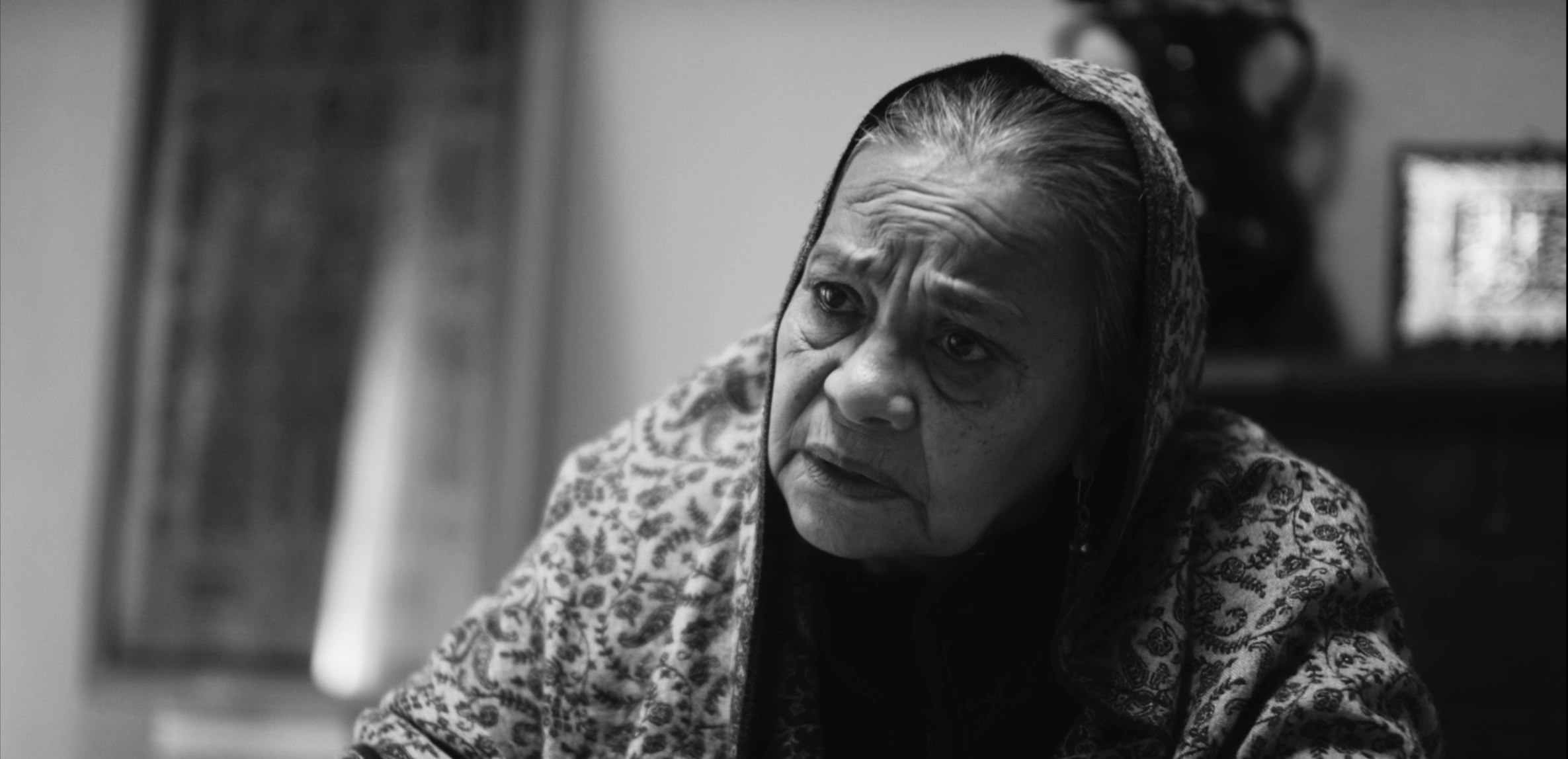”
Written byZubayr Charles
”
Images byLuqmaan Gierdien
Local Artists Collaborate On The ‘Oemmie’ Short Film To Tackle Gentrification In Bo-Kaap.
It is a warm summer’s evening in Bo-Kaap, just before sunset. I exit my home to our street which buzzes with children playing cricket. Neighbours lounge on their stoeps, hoping to catch a breeze, as they escape the heat of their homes. Through many wide smiles and exclamations of Asalaamu Alaykum (Peace be upon you), I turn left onto the cobbled Pentz Street and trek toward the Bo-Kaap Cultural Hub, formally known to many as Boorhaanol. The atmosphere feels familiar. Intrinsic. There is something so distinct about social gatherings in Bo-Kaap. I cannot effectively place my finger on it, but in this moment, there is a unified electric anticipation that hangs in the air. As I roam around the various stalls outside of the hub, observing community members selling breyani, pannekoekies, and veggies from the Bo-Kaap Helpers Garden, I feel content to be part of this community, and more honoured to be part of the collective excitement for the short film we are about to witness, titled ‘Oemmie’.
It is just after Maghrieb (sunset prayer time), and all those in attendance gather around to watch in the yard section of the Bo-Kaap Cultural Hub — a space I have always thought to perfect as an outdoor auditorium or theatre. The film opens with a verse from he 55th chapter in the Quran, Surah Ar-Rahman, “Fa-bi-ayyi ālā’i rabbikumā tukadhdhibān” (And which of the favours of your Lord would you deny?) — instantly anchoring the narrative’s Islamic, spiritual, and cultural consciousness. Written and directed for the screen by Taahir Sarguro, and adapted from a short story written by Yasser Booley, the film invites the audience into the world Oemmie’s home in Bo-Kaap — a place currently known to many for its history, iconic colourful houses, fine Cape Malay cuisine, the birthplace of Islam in South Africa, and a long array of other descriptions that would take up the space of this entire piece. More importantly, Bo-Kaap is a place I call home.
“I cannot effectively place my finger on it, but in this moment, there is a unified electric anticipation that hangs in the air. As I roam around the various stalls outside of the hub, observing community members selling breyani, pannekoekies, and veggies from the Bo-Kaap Helpers Garden, I feel content to be part of this community, and more honoured to be part of the collective excitement for the short film we are about to witness, titled Oemmie. “
Presently, I’m reminded of how, years ago, formal complaints were lodged against the athaan (call-to-prayer) in District Six. To many – including myself — it was baffling that newcomers would choose to settle in an area only to contest its longstanding traditions. But this is precisely how gentrification works: it creeps in, although subtly at first. And as I grew older and wiser, soon the plague was knocking at familiar doors. Gradually, through escalating rates and tariffs, businesses opening on various corners, along with high-rise buildings and commercialised office spaces invading, and foreigners investing in property — among some examples — Bo-Kaap too began to change… Some may argue that our area has always been changing due to outside forces constantly placing our area under threat. Families who had lived in Bo-Kaap for generations could no longer afford increased rent or rising bond repayments, and were ultimately forced to move out or sell. Whilst some may have received millions for their homes, there is a sentimental value attached to Bo-Kaap that cannot be measured in money or replicated elsewhere. And although protests in recent years have drawn attention to these changes, and our understanding of gentrification has grown, many remain unaware of how deeply our culture, religion, and customs are still under threat. With all these thoughts and emotions swirling within me, I internalise ‘Oemmie’ — a narrative set in a future Bo-Kaap where the athaan is no longer heard over loudspeakers.
Through the eyes of the character Oemmie, a seventy-year-old woman rooted in tradition, and her grandson, Gamiem, we, as an audience, are introduced to gentrified Bo-Kaap. The narrative begins with cinematographer Yaseen Hanslo using various establishing shots to intricately interweave subtle yet impactful symbolism. A low-angle cutaway of Oemmie’s lemon tree signifies her deep-rooted connection to the land. A wide shot of Nazier’s corner shop — where cracked walls, graffiti, vibrant colors, and the narrow uphill slope of Lower Bryant Street converge — reflects the resilience of Bo-Kaap amid change. Followed by the striking introduction of the lone minaret of the Leeuwen Street Mosque, which contrasts with Gamiem’s line about how newcomers complain about the “garaas” (noise). The close-ups in Oemmie’s home reveal her fine china, doily-styled table cloth, various Arabic rakam (calligraphy) frames, and a black salaah thobe (prayer attire) matched with a traditional shemagh (head scarf). Although this is fiction, and I have never been in Oemmie’s home, it feels so familiar to me. It is as if I can feel the miyang stokkies (incense) invade and waft through my nostrils. That is what a good film does — it tackles your senses and allows you to feel.

The dialogue is carefully curated for a Cape Malay ear. The mixture of Kaaps, Arabic, and Cape Muslim Vernacular is so intricate to Bo-Kaap, that the words are a character themselves: alive and breathing. Key words that strike my ears are: bilal (call-to-prayer), boeja (father), masiet (mosque), and Slamse-skole (school for Islamic thought). Just as Oemmie comments on the loss of customs and cultural nuances, the dialogue in the film serves as a reminder that our language must never be gentrified, ostrascised or erased. It is our duty to preserve the land and language of those who came before us.
Adaptor and director Taahir Sarguro handles the subject matter that is so close to my heart with clear intention. I am curious to know about his thought process is. Particularly with the genre of short film, where one literally has limited time to flesh out a narrative. Sarguro mentions the following, “I feel strongly about telling stories about our shared background, culture, and history.” According to Sarguro, the disappearance of the athaan (call-to-prayer) in the film serves as a larger metaphor for marginalised voices and disappearing traditions within Bo-Kaap, and Muslim communities as a whole. The film’s careful pacing and the use of Oemmie’s short silences between her pockets of speech act as resistance against a world increasingly indifferent to such nuances.
Taahir Sarguro’s passion as a filmmaker is matched by Yasser Booley’s original sense of purpose when drafting his first concept for ‘Oemmie’. As the original storyteller, Booley describes the process of bringing ‘Oemmie’ to life as one driven by intention, as he mentions that committing to an intention, acting on it, and then handing the outcome over to Allah is most important to him. In a post-film discussion, Booley reveals that after developing the original concept for ‘Oemmie’, he contacted Hanslo, and shortly thereafter, producer Amina Booley and Taahir quickly joined the project as adaptor and director, respectively. I find it fascinating how everything fell into place with this project, and how it took three months of on-and-off pre-production between day jobs, just two days of actual shooting, and roughly six weeks of focused work spread over two months to complete post-production.
Booley further outlines four clear aims for the project, “Firstly, I want to change the lens through which the Bo-Kaap is viewed — it should be viewed as more than just colourful houses, both locally and globally. Secondly, to create a platform for conversation among descendants of Bo-Kaap families. Thirdly, to stage an intentional resistance to the ongoing erasure of our living heritage using the media and arts. And finally, to establish a working relationship with local filmmakers, with the hope of producing commissioned films in the future.”
With those outlines in mind, I understand that Oemmie isn’t only about telling a story, it’s an act of defiance against larger corporations, geopolitics, and urbanisation. Booley’s vision extends beyond the film itself, as he states, “I want to change the lens at which the Bo-Kaap is looked at.”
The short film serves as a platform for conversation among current Bo-Kaap residents, particularly those who are descendants from generations and generations who have passed away. A group resistance against outside forces that are erasing our living heritage is incumbent. This can only be done through awareness and educating our people, and, quite frankly, creating a film is the best way to do so, as it provides a visual representation for issues that are overlooked in society.
As I leave the Bo-Kaap Cultural Hub and retrace my route back home, my feet imbibing the history that lies under my feet from the cobblestones, I have a newfound sense of purpose. Just as Yasser, Taahir, Yaseen, Amina, and the entire ‘Oemmie’ crew utilised their expertise to create this beautiful art, I too am inspired to revisit my awareness on the gentrification of Bo-Kaap. To the entire ‘Oemmie’ crew, I salute you. May the Almighty continue to bless you with opportunities, and as you give voice to the voiceless, create awareness of issues burdened by the current inhabitants of Bo-Kaap, and tell to tell the broader stories of our people, may your rizk (sustenance) continue to increase insha’allah (God Willing). And to you, my dear reader, next time you are in Bo-Kaap, I encourage you to pay attention to the overt and subtle changes. And as you look around, may these wise and final words of the character Oemmie herself resound in your head, “Het ôs danie genoeg gedoenie? (Haven’t we done enough?)”.





